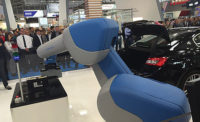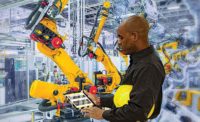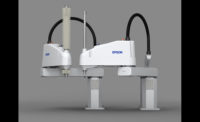More than 46,000 manufacturing engineers and managers from 47 countries attended Automatica 2018, which took place June 19-22 at the New Munich Trade Fair Centre in Germany.
Held every two years, this international trade fair brings together suppliers of robotics, vision systems, mechatronics and automation under one roof. Some 890 exhibitors from 30 countries displayed their wares in six halls encompassing more than 710,000 square feet of exhibit space.
The following are some of the new technologies on display at the event.
Omron’s New SCARA
Omron Adept Technologies Inc. introduced a new line of SCARA robots with a sleek design and enhanced performance.
The i4 SCARA robot is compact, fast, repeatable, easy to operate, and flexible for multiple configurations and applications.
The i4 robot communicates through EtherCAT, enabling synchronization between other automation devices. This facilitates advanced assembly and insertion processes that require high accuracy and demanding throughput. It also simplifies vision system integration.
The robot’s iCS controller is fully integrated into the machine’s stylized base, minimizing footprint. There’s no “flyover” cable above joint 1. The controller’s interactive software makes it easier for engineers to program and use the robot.
The robot’s built-in display is designed to simplify troubleshooting and predictive maintenance. To reduce unscheduled downtime, the i4 communicates with engineers using a light ring and display embedded into the base. The light ring serves as an indicator of the robot’s health, informing engineers of status changes and maintenance needs, such as “warranty update required.” Manual checks and maintenance plans are no longer necessary.
In spring 2019, Omron will introduce the first three models in the line: the i4-650, i4-750 and i4-850, which will have maximum horizontal reaches of 650, 750 and 850 millimeters, respectively. The robots can carry a maximum payload of 15 kilograms. The Z axis stroke can be 210 or 410 millimeters.
The robot will also be available in an IP65 model, a Class 10 clean room model, a static-dissipative model, and a model that uses H1 food-grade grease. An inverted model, for mounting on a ceiling, will also be available.
Mobile Dual-Arm Robot
Epson Robots showed off its new mobile, dual-armed collaborative robot, the WorkSense W-01.
The robot is equipped with six cameras: four on its head and one on each arm. This gives the robot human-like vision, enabling it to accurately detect an object’s position and orientation in three-dimensional space. Even if the robot is relocated, it can immediately start work with no
programming change required. This gives the robot the ability to flexibly adapt to sudden changes in production. So, for example, it can be wheeled to different locations to perform different tasks every day, if need be. The robot independently decides the path and orientation of its arms and is able to avoid obstacles.
The robot’s two seven-axis arms move like human arms. Each arm can move independently from one another to allow the robot to perform tasks that a single-arm robot cannot, such as tightening a screw in a component with one arm while holding the component in place with the other.
The robot’s arms are outfitted with Epson’s highly sensitive, precision force sensors. These enable the robot to perform delicate assembly, transport and other tasks that require human-like force control. Multipurpose hands that can grasp, grip and clamp objects of various shapes and sizes are included as standard end-of-arm tooling. They can manipulate tools and jigs that were designed for people.
The WorkSense brand name was coined to represent the concept of a robot that sees, senses, thinks and works. With its WorkSense robot, Epson is targeting market segments where demand for small-lot production and just-in-time manufacturing is particularly high, such as the automotive parts industry.
“With the help of a few intermediary steps and tools, the WorkSense W-01 is able to complete tasks autonomously that would previously have required a complicated, multi-robot setup,” says Volker Spanier, Epson’s head of robotic solutions for Europe, Middle East, Africa and Russia. “Bringing new flexibility to automation in Europe, we have begun working with our first global customer to automate some of its European manufacturing and are seeing firsthand the potential that this robot has.”
Exoskeleton Provides Support
Comau unveiled the MATE, an innovative wearable exoskeleton that assists and supports workers performing repetitive and strenuous tasks on the assembly line.
The exoskeleton is the result of a partnership between Comau; Össur, a manufacturer of noninvasive orthopedic devices; and IUVO, a spin-off company of the BioRobotics Institute of the Sant’Anna School of Advanced Studies in Pontedera, Italy.
The exoskeleton has an advanced, spring-based passive structure. The lightweight structure fully follows the movements of the upper limb without resistance or misalignment. Compact and breathable, the device delivers postural support without the need for batteries, motors or other failure-prone devices. The exoskeleton is fully able to replicate any movement of the shoulder while adhering to the body like a second skin.
The device enables assemblers to perform repetitive, strenuous tasks with less fatigue, and less fatigue equates to better quality and higher precision over the course of a shift. Tests have shown that the MATE reduces shoulder muscle activity by up to 50 percent.
“MATE has been designed in close collaboration with factory workers, responding directly to their specific needs,” says Tobias Daniel, Comau’s vice president for global sales and marketing of robotics and automation products. “With our exoskeleton, they will be able to do the same tasks, but with less fatigue.
“For Comau, this is also an extraordinary opportunity to reach a global market that…grew by more than 60 percent from 2015 to 2017 and is estimated to continue growing at a rate of 25 percent each year until 2020. We believe that the industrial sector will represent about one third of the exoskeleton’s applications.”
The MATE is the first of a series of wearable robotics that Comau is developing in partnership with IUVO and Össur. The goal of the partnership is to evolve human-machine collaboration within diverse sectors, including biomedical, manufacturing and consumer applications.
Unique Grippers
OnRobot presented three new grippers at Automatica: the Gecko gripper, Polyskin tactile gripper, and RG2-FT gripper.
Inspired by nature, the Gecko gripper uses the same adhesive system for gripping as the feet of a gecko. The gripper has four square pads on its face that consist of millions of fine fibers that adhere to the surface of the workpiece and generate strong van der Waals forces.
Originally developed by the NASA Jet Propulsion Laboratory, the technology can be used for handling large, flat objects without the need for suction cups or compressed air. Unlike vacuum grippers, the Gecko gripper can handle perforated or porous workpieces, such as printed circuit boards, without any problems.
To grip an object, a robot presses the gripper against it with a force of 125 newtons. Gripping is instantaneous. The gripper can release an object in 500 milliseconds. It will continue to hold an object in the event of a power loss.
The gripper’s maximum payload depends on what’s being handled. The gripper can carry a polished steel sheet weighing 8.2 kilograms, an acrylic sheet weighing 8.2 kilograms, a glass sheet weighing 6.6 kilograms, or standard sheet metal weighing 6.1 kilograms.
The gripper is equipped with a load sensor, an ultrasonic range sensor, and an automatic piezoelectric cleaning system. The latter is important because the gripper’s performance depends on the cleanliness of the pads. The system can set to clean the pads every 15 seconds, 2 minutes or 15 minutes, depending on the application. After 100,000 cycles, the gripper must be swapped out for cleaning.
The Polyskin tactile gripper handles sensitive or irregular objects. Both fingers can be individually actuated and have integrated tactile sensors at the fingertips. This allows the gripper to precisely measure the condition of the workpiece surfaces and align its gripping processes accordingly.
With a maximum stroke of 70 millimeters (35 millimeters per finger) and a maximum gripping force of 400 newtons (200 newtons per finger), the device can be programmed for force- or position-controlled operation. Finger speed ranges from 5 to 60 millimeters per second.
The gripper is equipped with sensors for bump detection and temperature measurement. Maximum payload is 10 kilograms, depending on the object’s coefficient of friction. It will continue to hold an object in the event of a power loss.
The RG2-FT is a variation of the company’s established RG2 gripper. It is equipped with a proximity sensor as well as force and torque sensors at the fingertips. These sensors enable the gripper to detect when an object is slipping from its grasp before the object can fall.
It has a maximum stroke of 100 millimeters and a maximum gripping force of 40 newtons.
Modular SCARAs
Stäubli Robotics displayed its new TS2 line of SCARA robots.
“We have given our SCARAs a complete makeover,” says Gerald Vogt, director of Stäubli Robotics. “They are now modular in design and, for the first time, incorporate our very own JCS drive technology, which has been setting new standards in our six-axis machines. This technology is the key to the enormous performance gains of the four-axis TS2. Hollow-shaft technology has made possible a unique clean-room design that makes external cabling a thing of the past.”
The TS2 line is characterized by their compact, enclosed design with internal media and supply lines. There is no external bundling of cables and thus no irregular contours, sources of mechanical failure or avoidable particle emissions. Dead spaces have been eliminated. The housing is completely sealed. The quill can be protected with a cover affixed with special screws. And, connections can be concealed under the robot pedestal.
Four models are available—the TS2-40, TS2-60, TS2-80 and TS2-100—with a working radius of 400 to 1,000 millimeters.
For the first time, the SCARA can be ordered with an integrated tool-change system, which enables the robot’s end-effector to be changed automatically or manually. A bayonet-style locking mechanism ensures a fast and secure connection. All media and signal connections are automatic.
All the machines in the series have the same robot pedestal as the company’s six-axis TX2 robots. In addition, the forearms, axes and drives are identical on certain models. For example, the TS2-40 and TS2-60 share one size forearm, while the TS2-80 and TS2-100 share another.
“This modular design is a way of significantly reducing delivery times for the new SCARAs,” says Vogt. “In addition, we save unnecessary costs and rationalize our spare parts provision.”
Variants are available for use in clean rooms and for medical, pharmaceutical, food and electronics assembly applications.
Digital Robot Control
ABB Inc. launched its new OmniCore robot controller family at Automatica.
Fifty percent smaller than the ABB’s previous generation of controller, OmniCore offers three mounting options: tabletop, rack-mount and vertical mount.
The controller comes with a new generation of ABB’s powerful, yet intuitive, operating system, RobotWare7. It incorporates new features and functions that promise to make robots more capable than ever before.
The software is accessed through a newly designed, ergonomic FlexPendant. The teach pendant has a large, capacitive multi-touch display that accepts the same standard gestures, such as pinch, swipe and tap, that are used to interact with a smartphone. The pendant can be unplugged during operation and shared among several robots. Extensive customization possibilities are available. Hard buttons—including four user-programmable ones—are provided for common operations. The pendant also has a 3D joystick for intuitive robot movement.
The controller is designed to support ABB’s new small robots, including the company’s new single-arm YuMi collaborative robot. Support for other robots will be rolled out gradually.
OmniCore is equipped with ABB’s SafeMove2 software, which allows people and robots to work safely and closely together without compromising productivity. Thus, the new controller can turn any connected industrial robot into a collaborative robot.
ABB’s Ability digital platform and Ability Connected Services are also built into the new controller. The ABB Ability platform is an integrated industrial Internet platform and cloud infrastructure that enables manufacturers to harness the power of industrial data. The controller seamlessly connects with a wide variety of fieldbuses, vision systems and force control technology.












